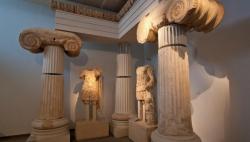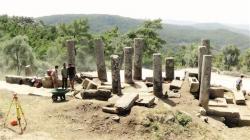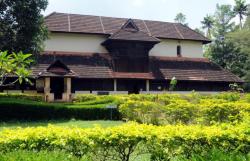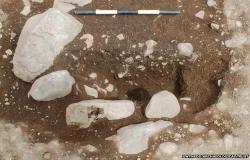INSTITUT SUPERIEUR D'ANTHROPOLOGIE
INSTITUTE OF ANTHROPOLOGY
ONLINE COURSES / COURS A DISTANCE
SUMMER TERM : JULY 2014
REGISTER NOW
GRECE –  Thessalonique - Local residents of Thessaloniki in northern Greece are outraged by a decision to build an apartment block on top of a recently discovered ancient temple in the heart of the city. The temple of the goddess Aphrodite, which was brought to Thessaloniki from the city of Aenea in the 6th century B.C., is said to be priceless in value. The temple lies in an area now called Dioikitirio (administrative centre). In Roman times the area was known as the Square of the Sacred Ones, as most of the city’s temples were concentrated there. The ancient Greek temple was brought to light in 2000 after the demolition of a two-storey building. The archaeologists found the eastern part of the temple’s krepis, statues of Greek and Roman times, and numerous fragments of architectural parts. While most of the temple remains in Dioikitirio, some parts including the columns of the temple, as well as many of the other remains, are currently being exhibited in the Archaeological Museum of Thessaloniki. According to the school of Architecture of the Aristotle University of Thessaloniki, Antigonidon square can be reformed in two levels, so that the temple would be rebuilt and become visible in its entirety.
Thessalonique - Local residents of Thessaloniki in northern Greece are outraged by a decision to build an apartment block on top of a recently discovered ancient temple in the heart of the city. The temple of the goddess Aphrodite, which was brought to Thessaloniki from the city of Aenea in the 6th century B.C., is said to be priceless in value. The temple lies in an area now called Dioikitirio (administrative centre). In Roman times the area was known as the Square of the Sacred Ones, as most of the city’s temples were concentrated there. The ancient Greek temple was brought to light in 2000 after the demolition of a two-storey building. The archaeologists found the eastern part of the temple’s krepis, statues of Greek and Roman times, and numerous fragments of architectural parts. While most of the temple remains in Dioikitirio, some parts including the columns of the temple, as well as many of the other remains, are currently being exhibited in the Archaeological Museum of Thessaloniki. According to the school of Architecture of the Aristotle University of Thessaloniki, Antigonidon square can be reformed in two levels, so that the temple would be rebuilt and become visible in its entirety.
http://greece.greekreporter.com/2014/07/15/parthenon-of-thessaloniki-to-be-buried/?
TURQUIE –  Labranda - Archaeological excavations have started in the ancient city of Labranda, located in the western province of Muğla’s Milas. Excavations in the ancient city were initiated in 1948 by Swedish academics. Now works are being carried out by Milas Museum Directorate officials. Academics and workers from Colombia, the U.S., France, England, Sweden, Greece, Romania, Bulgaria, Slovakia, India and Turkey are working for the excavations this year and the first ancient fountain, discovered in the ancient city last year, is being unearthed under the observation of Associate Professor Olivier Henry from the French Institute of Anatolian Studies. Speaking about the project, Henry said it would continue in the Hellenistic memorial fountain, which was estimated to date back to the 4th century B.C., the Roman bath, andron (a historic building), the mausoleum and acropolis. Henry also complained about the mine pits around the ancient city, saying they were damaging the city. He said one of the four mine pits in the area helped them and supported their work, but the other three damage the ancient city. He said the trucks used in the mine were carrying feldspar metal and they had to breathe this metal during their work. “Also, dynamite used by the mine companies changed the parameters of the ancient city,” he said, adding he would organize a meeting in the coming days to the change the road that the trucks used for mining take.
Labranda - Archaeological excavations have started in the ancient city of Labranda, located in the western province of Muğla’s Milas. Excavations in the ancient city were initiated in 1948 by Swedish academics. Now works are being carried out by Milas Museum Directorate officials. Academics and workers from Colombia, the U.S., France, England, Sweden, Greece, Romania, Bulgaria, Slovakia, India and Turkey are working for the excavations this year and the first ancient fountain, discovered in the ancient city last year, is being unearthed under the observation of Associate Professor Olivier Henry from the French Institute of Anatolian Studies. Speaking about the project, Henry said it would continue in the Hellenistic memorial fountain, which was estimated to date back to the 4th century B.C., the Roman bath, andron (a historic building), the mausoleum and acropolis. Henry also complained about the mine pits around the ancient city, saying they were damaging the city. He said one of the four mine pits in the area helped them and supported their work, but the other three damage the ancient city. He said the trucks used in the mine were carrying feldspar metal and they had to breathe this metal during their work. “Also, dynamite used by the mine companies changed the parameters of the ancient city,” he said, adding he would organize a meeting in the coming days to the change the road that the trucks used for mining take.
http://www.hurriyetdailynews.com/mine-pits-damage-ancient-city-labranda.aspx?pageID=238&nID=69050&NewsCatID=375
INDE –  Nedumangad - The Koyikkal Palace, which was the royal headquarters of the Perakam dynasty, is set to get a major facelift utilisng funds provided by the Union and State governments.The palace, which was constructed over three centuries ago, is an important stop-over destination for tourists visiting Ponmudi and an itinerary of guided tours. The museum has an impressive collection of household utensils, including wooden kitchenware made in brass and copper representing the lifestyle of the people and coins of different ages.
Nedumangad - The Koyikkal Palace, which was the royal headquarters of the Perakam dynasty, is set to get a major facelift utilisng funds provided by the Union and State governments.The palace, which was constructed over three centuries ago, is an important stop-over destination for tourists visiting Ponmudi and an itinerary of guided tours. The museum has an impressive collection of household utensils, including wooden kitchenware made in brass and copper representing the lifestyle of the people and coins of different ages.
http://www.thehindu.com/news/cities/Thiruvananthapuram/koyikkal-palace-to-get-a-facelift/article6206240.ece?utm_source=RSS_Feed&utm_medium=RSS
ROYAUME UNI –  Hen Gastell - Archaeologists and volunteers in Gwynedd are hoping to unearth an Iron Age hill fort as part of a UK-wide Festival of Archaeology. The team is excavating an ancient ditched enclosure at Hen Gastell in Llanwnda, near Caernarfon. Surveys in 2013 suggested the site may be medieval rather than Iron Age. Site director Jane Kenny said: "There are definitely at least five postholes, which is really exciting, because postholes mean there was a building."
Hen Gastell - Archaeologists and volunteers in Gwynedd are hoping to unearth an Iron Age hill fort as part of a UK-wide Festival of Archaeology. The team is excavating an ancient ditched enclosure at Hen Gastell in Llanwnda, near Caernarfon. Surveys in 2013 suggested the site may be medieval rather than Iron Age. Site director Jane Kenny said: "There are definitely at least five postholes, which is really exciting, because postholes mean there was a building."
http://www.bbc.co.uk/news/uk-wales-north-west-wales-28273115
ROYAUME UNI –  Petworth - An excavation to uncover a house used by King Henry VIII in Petworth is hoped to unearth some hidden mysteries this month. This is an incredibly exciting opportunity to find out more about a period of the Park’s past which is little understood.Petworth began its ties with Henry VIII when the park was gifted to him in 1535 by Henry Percy, 6th Earl of Northumberland.The monarch immediately set about expanding and enhancing the Park, possibly building a Banqueting House to entertain his royal guests. The site of this building has so far eluded archaeologists. However, in 2013 a small evaluation trench on the hill northwest of the house uncovered stone walls, foundations and brick terraces. This breakthrough, along with finds of Tudor pottery, foreign imports from across the continent and high status items such as a bronze cavalry spur is very encouraging. For many years there has been speculation that a defensive structure was built at Petworth after the Norman invasion of 1066. There are scattered clues alluding to this, such as a mysterious tower, shown on a map of 1610. The Elizabethan accounts for the park also record a ‘Keeper of the House’ as well as a ‘Constable of the Castle’.
Petworth - An excavation to uncover a house used by King Henry VIII in Petworth is hoped to unearth some hidden mysteries this month. This is an incredibly exciting opportunity to find out more about a period of the Park’s past which is little understood.Petworth began its ties with Henry VIII when the park was gifted to him in 1535 by Henry Percy, 6th Earl of Northumberland.The monarch immediately set about expanding and enhancing the Park, possibly building a Banqueting House to entertain his royal guests. The site of this building has so far eluded archaeologists. However, in 2013 a small evaluation trench on the hill northwest of the house uncovered stone walls, foundations and brick terraces. This breakthrough, along with finds of Tudor pottery, foreign imports from across the continent and high status items such as a bronze cavalry spur is very encouraging. For many years there has been speculation that a defensive structure was built at Petworth after the Norman invasion of 1066. There are scattered clues alluding to this, such as a mysterious tower, shown on a map of 1610. The Elizabethan accounts for the park also record a ‘Keeper of the House’ as well as a ‘Constable of the Castle’.
http://www.wscountytimes.co.uk/news/local/petworth-dig-to-uncover-king-henry-s-history-1-6173772